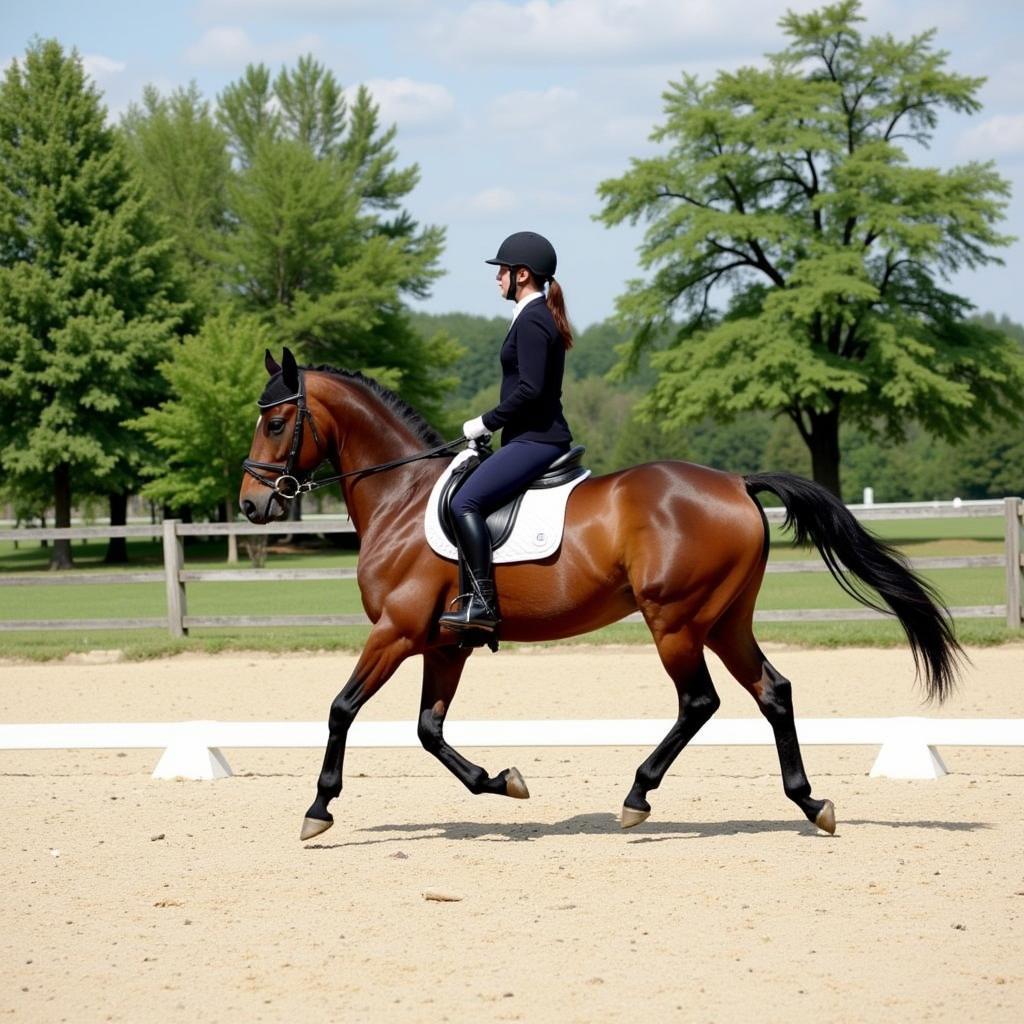Flying changes are the hallmark of a well-trained performance horse or pony. Executing this elegant maneuver, where the horse changes its lead canter leg while airborne, requires dedication, precise training, and a harmonious partnership between horse and rider. This article delves into the intricacies of training for flying changes, addressing common challenges and offering valuable insights to elevate your performance horse or pony’s abilities.
Understanding the Mechanics of Flying Change Performance Horses & Ponies
Before embarking on flying change training, a solid foundation in basic dressage movements is crucial. The horse must be comfortable and responsive to the rider’s aids at the walk, trot, and canter, exhibiting clear rhythm and balance. Counter-canter work is particularly important, as it prepares the horse for the shift in balance required for a flying change. Think of counter-canter as a stepping stone, teaching the horse to maintain balance and impulsion on the “wrong” lead, preparing them for the seamless transition of the flying change.
Prerequisites for Smooth Flying Changes
Several key elements contribute to successful flying changes in performance horses & ponies. A straight, balanced canter is paramount, ensuring the horse is not leaning or drifting. Furthermore, the rider must be able to apply precise aids, clearly communicating the desired change without disrupting the horse’s rhythm. Finally, consistent training and positive reinforcement are vital for building the horse’s confidence and encouraging a willing partnership.
 Dressage Horse Preparing for Flying Change
Dressage Horse Preparing for Flying Change
Training Techniques for Flying Changes in Horses and Ponies
Introducing flying changes should be a gradual process, tailored to the individual horse’s learning style and physical capabilities. Starting with simple changes, such as a change through the walk or trot, helps the horse understand the concept of changing leads. As the horse progresses, the rider can introduce the flying change itself, typically in a corner or on a diagonal line where the change in direction aids the horse’s balance. Clear and consistent aids are crucial; the rider should use their legs and seat to signal the change, maintaining a light and steady contact with the reins.
Common Challenges and Troubleshooting
Even with diligent training, challenges can arise. A common issue is the “late behind” change, where the hind legs change leads after the front legs. This can be addressed by focusing on maintaining impulsion and ensuring the horse is truly straight before asking for the change. Another frequent problem is the “cross-canter,” where the horse canters on one lead in front and the other behind. This often stems from a lack of balance or straightness and requires careful corrective exercises.
Maintaining and Refining Flying Change Performance
Once the horse consistently performs clean flying changes, regular practice is essential to maintain and refine the maneuver. Varying the location and frequency of changes helps prevent the horse from anticipating and encourages responsiveness to the rider’s aids. Incorporating flying changes into more complex movements, such as tempi changes, further develops the horse’s coordination and athleticism.
“Consistent training and attention to detail are crucial for achieving beautiful, effortless flying changes,” says renowned equine trainer, Amelia Hartford. “It’s about building a partnership based on trust and clear communication.”
The Role of Rider Biomechanics in Flying Changes
The rider’s position and balance play a significant role in the quality of the flying change. A centered and balanced seat allows the rider to apply aids effectively without interfering with the horse’s movement. Quiet hands and a following seat are essential for maintaining a steady connection and allowing the horse to move freely through the change.
“The rider’s body language speaks volumes to the horse,” explains Dr. William Davies, equine biomechanics specialist. “A balanced and relaxed rider transmits confidence and encourages a harmonious partnership.”
Conclusion
Mastering flying changes in performance horses & ponies is a testament to the dedication and skill of both horse and rider. By focusing on building a strong foundation, applying consistent training techniques, and addressing challenges effectively, you can unlock the potential for elegant and effortless flying changes, elevating your performance to new heights.
FAQ
- When should I start training my horse for flying changes?
- What are the most common mistakes riders make when asking for a flying change?
- How can I improve the quality of my horse’s flying changes?
- What are tempi changes, and how do they relate to flying changes?
- How can I tell if my horse is ready to learn flying changes?
- What exercises can I do to prepare my horse for flying changes?
- How often should I practice flying changes with my horse?
For assistance contact Phone Number: 0772127271, Email: [email protected] Or visit: QGM2+WX2, Vị Trung, Vị Thuỷ, Hậu Giang, Việt Nam. We have a 24/7 customer service team.